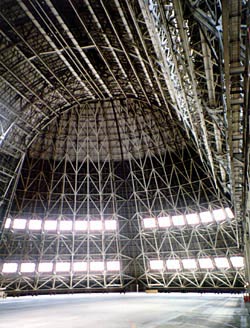Admiral William A. Moffett is credited with the creation of the two Naval Air Stations commissioned in the early 1930s to port the two U.S. Naval Airships (dirigibles). The Naval Air Station Sunnyvale, California, was the Pacific coast location selected with help from northern Californian politicians and the leadership of the Chambers of Commerce from Mountain View to San Jose. More commonly known as Moffett Field, the U.S. Naval Air Station Sunnyvale, California, Historic District consists of a large number of buildings that were constructed from the 1930s on. By far the most famous and visible of these are Hangars #1, #2 and #3, which dwarf the surrounding buildings, standing as testament to the engineering skills of their builders.

Towering majestically in the northeast corner of Santa Clara Valley is Hangar #1 constructed in 1933 to house the Navy dirigible USS Macon. Named as a Naval Historical Monument in the early 1950s, the hangar is constructed on an amazing network of steel girders sheathed with galvanized steel. It rests firmly upon a reinforced pad anchored to concrete pilings. The floor covers eight acres and can accommodate 10 football fields. "Number One," as it is popularly referred to, is 1,133 feet long and 308 feet wide. Its walls curve upward and inward, to form an elongated dome 198 feet high. Unique and spectacular are the "orange peel" doors, weighing 500 tons each. The doors are operated by an electrical control panel. Each door is powered by a 150-horsepower motor. One of the most recognizable landmarks in the San Francisco Bay Area, Hangar #1 and the original base are significant in the history of Naval Aviation, defense and in the development of the Santa Clara Valley. Making use of the facility location and landing field, NASA Ames Research Center is located to the north adjacent to the original plaza boundary and at the north boundary of the historic district. It was here that some of the original moon rocks taken from the Apollo lunar landings were studied by NASA geologists.
The hangar's interior is so large that fog sometimes forms near the ceiling. A person unaccustomed to its vastness is susceptible to optical disorientation. Looking across its deck, airplanes and tractors look like toys. Along its length, maintenance shops, inspection laboratories and offices help keep the hangar busy. Looking up, you can see a network of catwalks for access to all parts of the structure. Two elevators meet near the top, allowing maintenance personnel to get to the top quickly and easily. Narrow gauge tracks run the length of the hangar. During the lighter- than-air period of dirigibles and non-rigid aircraft, the rails extended across the apron and into the fields at each end of the hangar. This tramway facilitated the transportation of an airship on the mooring mast to the hangar interior or to the flight position. During the brief period that the USSMacon was based at Moffett from October 1933 until it was lost at sea in February 1935, Number One not only accommodated the giant airship but several smaller non-rigid LTA craft simultaneously. Hangar One is one of the most important hangars in the world. Hangars #2 and #3 are significant more for their size than their unique styling or design. Along with Hangar #1, these two buildings help define the South San Francisco Bay Area from all distant directions. The style of the other buildings on the base is largely Spanish Colonial Revival, mostly built in the 1930s, with some International style buildings constructed in the 1940s and beyond. The Moffett Field Historical Society was founded in May of 1993. Until recently, their museum was located in historic "Hangar One."
Visit the National Park Service Travel American Aviation to learn more about Aviation related Historic Sites.
Last updated: September 3, 2017
